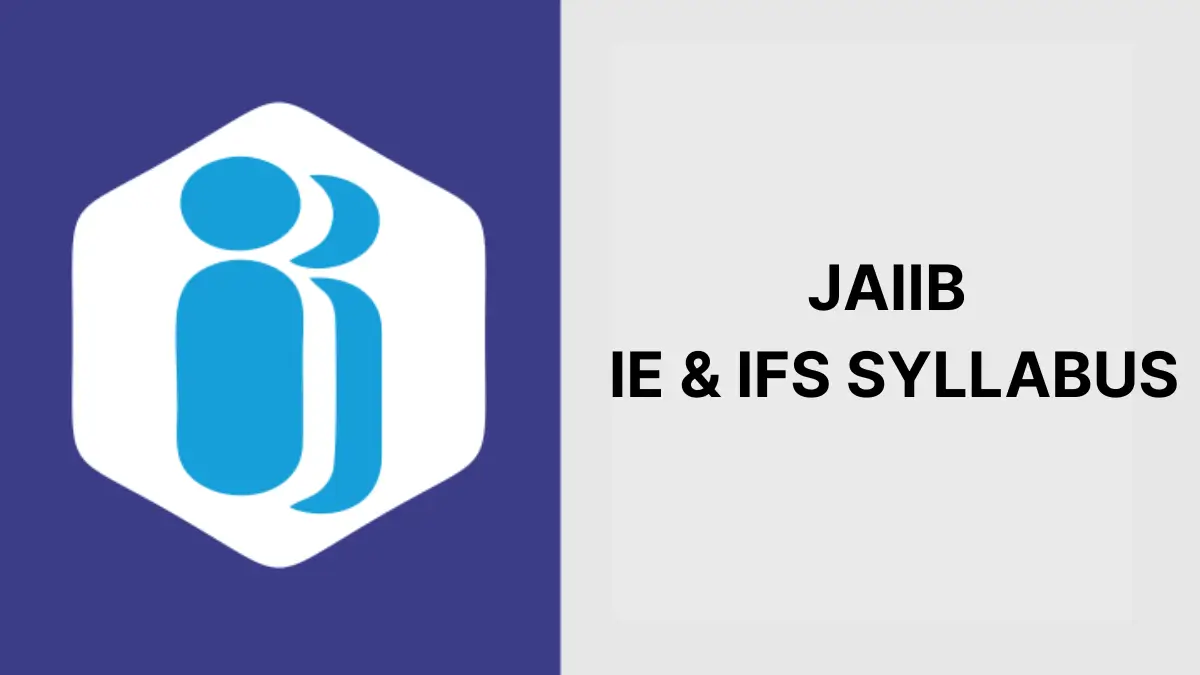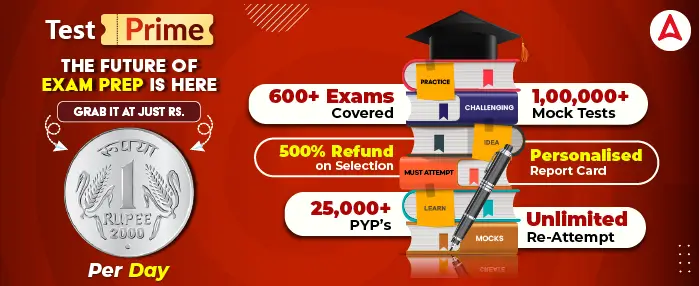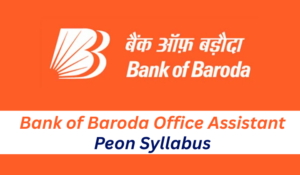The Junior Associate of the Indian Institute of Bankers (JAIIB) exam is an essential qualification for banking professionals looking to enhance their understanding of banking operations and progress in their careers. One of the core papers in the JAIIB exam is Indian Economy and Indian Financial System (IE & IFS). This paper is the first among the four compulsory subjects and focuses on providing candidates with knowledge of the Indian economic environment and the structure of the financial system.
JAIIB IE & IFS Syllabus 2025
The syllabus for IE & IFS is structured into four modules. Each module covers specific areas related to the Indian economy and the functioning of the financial system.
Module A: Indian Economic Architecture
1. Overview of Indian Economy
| Topic | Key Aspects |
| Evolution |
From agrarian structure → colonial exploitation → planned development → liberalization → digital economy
|
| Pre-British Economy |
Self-sustaining village economies, strong handicrafts, agrarian base
|
| Till 2008 & After |
Pre-2008: High GDP growth; Post-2008: Global slowdown, focus on resilience and reforms
|
| Basic Characteristics |
Mixed economy, large workforce, dominance of agriculture, growing service sector
|
| Structural Changes |
Decline in agriculture’s GDP share, rise in services and industrial output
|
2. Economic Planning in India
| Sub-Topic | Details |
| Definition |
Planned use of resources to achieve specific economic goals
|
| History |
Initiated in 1951 with the First Five-Year Plan
|
| Objectives |
Growth, poverty reduction, self-reliance, modernization, employment
|
| Types of Planning |
Perspective, annual, five-year plans, indicative planning
|
| Achievements |
Industrial base expansion, Green Revolution, poverty reduction, human capital
|
| Resources |
Tax revenues, deficit financing, external aid, domestic savings, PSU revenues
|
3. Sectors of Indian Economy
| Sector | Key Elements |
| Primary |
Agriculture, mining – crucial for employment
|
| Secondary |
Industry, manufacturing – rising employment and exports
|
| Tertiary |
Services – major GDP contributor (IT, banking, education)
|
| Quaternary & Quinary |
Knowledge sector & high-level decision-making services
|
| Revolutions |
Green (agriculture), White (milk), Blue (fisheries), Pink (onion/meat), Yellow (oilseeds)
|
| Other Concepts |
Sunrise sectors (e.g., EVs, AI), GDP distribution, organized vs unorganized sectors
|
4. Priority Sector & MSME
| Area | Details |
| Priority Sector |
Agriculture, MSMEs, education, housing, social infrastructure, renewable energy
|
| PSL Norms |
Mandated lending quotas for banks to specified sectors
|
| MSME Definition |
Micro, Small, and Medium Enterprises (based on investment and turnover)
|
| MSME Role |
Employment generation, exports, GDP contributor (~30%)
|
| Key Initiatives |
Atmanirbhar Bharat, Make in India, Start-Up India, Stand-Up India
|
5. Infrastructure (Physical + Social)
| Type | Components |
| Physical |
Energy (power, renewables), transport (rail, road, aviation)
|
| Social Infrastructure |
Health, education, sanitation, family welfare
|
| Link to Economy |
Backbone for industrial growth, human capital formation, inclusive development
|
6. Globalisation and India
| Topic | Description |
| Definition |
Integration of national economy with global markets
|
| Impact on India |
FDI inflows, tech transfers, export rise, inequality issues
|
| Challenges |
Jobless growth, vulnerable sectors
|
| Reverse Globalisation |
Rise of protectionism, reshoring, tariffs, trade tensions
|
7. Economic Reforms
| Area | Transformation |
| Overview |
1991 liberalization marked major shift
|
| Real Sector |
Deregulation, privatization
|
| Financial Sector |
Banking reforms, NPA resolution, digital finance
|
| Global Integration |
WTO, FDI, open trade
|
| Reform Phases |
LPG reforms, second-generation reforms (GST, IBC)
|
8. Foreign Trade, Investment & Development
| Topic | Insights |
| FTP History |
1990s reforms liberalized trade
|
| FTP 2015–20 |
Export incentives, SEZs, e-commerce boosts
|
| Upcoming Challenges |
Digital trade, logistics, WTO disputes
|
| FDI/FII Trends |
Sectoral caps, PLI schemes, Make in India
|
| Growth vs Development |
Development includes human welfare, not just output
|
9. International Economic Organizations
|
Organization
|
Relevance to India
|
| IMF & World Bank |
Financial aid, technical support, macroeconomic stability
|
| WTO |
Trade dispute settlement, trade facilitation
|
| Regional Blocs |
SAARC, BRICS, G20 – cooperative frameworks
|
| Recent Issues |
Pandemic response, debt distress, multilateral reforms
|
10. Climate Change & Sustainable Development
| Topic | Key Points |
| SDGs |
17 goals by 2030 (e.g., no poverty, clean energy, climate action)
|
| India’s Progress |
Ujjwala Yojana, Jal Jeevan, Swachh Bharat, solar missions
|
| Climate Issues |
Carbon emissions, floods, droughts
|
| CSR Activities |
Mandatory CSR under Companies Act, corporate-led sustainability efforts
|
11. Contemporary Challenges in Indian Economy
| Issue |
Explanation
|
| Poverty |
Absolute and relative poverty, urban slums
|
| Jobless Growth |
High GDP with low employment elasticity
|
| Inequality |
Wealth concentration, regional imbalances
|
| Migration |
Urban overcrowding, pressure on housing and infrastructure
|
| Pandemic Impact |
Health, livelihoods, informal sector worst-hit
|
| Remedies |
Skilling, rural employment, social security, tech adoption
|
Module B: Economic Concepts Related to Banking
1. Fundamentals of Economics, Microeconomics, Macroeconomics & Types of Economies
| Topic |
Key Aspects
|
| Economics Introduction |
Study of scarcity and resource allocation for maximizing utility
|
| Microeconomics |
Focus on individual markets, consumer behavior, and firm production
|
| Macroeconomics |
Broader view focusing on national and global economic indicators
|
|
Types of Economies
|
|
| Market Economy |
Decentralized decision-making, prices determined by supply and demand
|
| Command Economy |
Centralized control, government determines production and pricing
|
| Mixed Economy |
Combination of market and command economy features (India’s model)
|
2. Supply and Demand
| Sub-Topic | Details |
| Demand Schedule |
Shows quantity demanded at different price levels
|
| Forces Behind Demand Curve |
Income, price of related goods, preferences, expectations
|
| Shifts in Demand |
Increase or decrease in demand due to factors other than price
|
| Supply Schedule |
Shows quantity supplied at different price levels
|
| Forces Behind Supply Curve |
Cost of production, technology, government regulations
|
| Shifts in Supply |
Changes in supply due to external factors like production costs
|
| Equilibrium |
Point where supply equals demand, stabilizing price and quantity
|
| Effects of Shifts |
Price and quantity change depending on which curve shifts
|
| Price and Quantity Changes |
Understanding impacts of supply and demand changes on price and quantity
|
3. Money Supply and Inflation
| Concept |
Explanation
|
| What is Money? |
A medium of exchange, store of value, unit of account, and standard of deferred payment
|
| Money Supply |
Total amount of money in circulation within the economy
|
| Inflation |
Rise in general price levels, eroding purchasing power
|
| Causes of Inflation |
Demand-pull (excess demand), cost-push (rising production costs), built-in inflation (wage-price spiral)
|
| Measures of Inflation |
Consumer Price Index (CPI), Wholesale Price Index (WPI), GDP Deflator
|
4. Theories of Interest
| Theory | Key Points |
| Classical Theory |
Interest rate determined by savings and investment equilibrium
|
| Keynes’ Liquidity Preference |
Interest rates determined by demand for and supply of money
|
| Money Demand Curve |
Relationship between interest rates and the quantity of money demanded
|
| Determination of Interest Rate |
Equilibrium in the money market balancing demand and supply of money
|
| Increase in Money Supply |
Lowers interest rates, increases investment and spending
|
| Shifts in Money Demand |
Changes in liquidity preference (e.g., higher precautionary demand)
|
| IS-LM Curve Model |
Hicks-Hansen synthesis, showing equilibrium between goods and money markets
|
5. Business Cycles
| Concept | Details |
| Characteristics |
Fluctuations in economic activity over time, reflecting boom and recession phases
|
| Phases | |
| Expansion |
Rising output, employment, and consumer demand
|
| Peak |
Maximum economic output, low unemployment
|
| Recession |
Economic slowdown, high unemployment, declining demand
|
| Trough |
Lowest point, marking recovery or depression
|
| Recovery |
Gradual return to growth post-recession
|
6. Monetary Policy and Fiscal Policy
|
Policy Type
|
Details |
| Monetary Policy |
Control of the money supply by the central bank to stabilize the economy
|
|
Tools of Monetary Policy
|
|
| Open Market Operations |
Buying/selling government securities to influence money supply
|
| Repo Rate |
Interest rate at which banks borrow from the central bank
|
| Cash Reserve Ratio (CRR) |
Minimum percentage of deposits banks must keep with the central bank
|
| Monetary Policy Response to Global Financial Crisis |
Rate cuts, liquidity injection, financial market stabilization
|
| Fiscal Policy |
Government spending and taxation policies to influence economic activity
|
| FRBM Act |
Fiscal Responsibility and Budget Management Act, aiming to control budget deficits
|
7. National Income and GDP Concepts
| Topic |
Explanation
|
| Computation of National Income |
Methods: Income, Expenditure, and Output approach
|
| GDP (Gross Domestic Product) |
Total value of goods and services produced in a country within a year
|
| Utility of GDP |
Economic health indicator, policy planning, international comparisons
|
8. Union Budget
| Area | Key Points |
| Receipts |
Government income from taxes, non-tax revenues, borrowings
|
| Expenditure |
Spending on government services, infrastructure, defense, welfare
|
| Plan Expenditure |
Investment in economic and social development programs
|
|
Deficit Concepts
|
|
| Revenue Deficit |
Difference between revenue receipts and expenditure
|
| Fiscal Deficit |
Borrowing requirements of the government
|
| Primary Deficit |
Fiscal deficit excluding interest payments
|
Module C: Indian Financial Architecture
1. Indian Financial System – An Overview
| Phase | Key Features |
| What is a Financial System? | Framework for financial transactions, mobilizing savings & allocating resources |
| Phase I: Pre-1951 | Dominance of unorganized banking, limited access, Presidency Banks & Imperial Bank |
| Phase II: 1951–Mid-1980s | Nationalization of banks, establishment of RBI & DFIs |
| Phase III: Post-1990s | Liberalization, private banks, tech adoption, financial inclusion focus |
| Narasimham Committee (1991) | Suggested banking sector reforms, NPA management, autonomy to banks |
| Reforms (1992–2008) | Capital adequacy norms, asset classification, risk management, Basel norms |
| Present Status | Digital banking, inclusive finance, diversified financial products & services |
2. Indian Banking Structure
| Component | Details |
| Functions of Banks | Accepting deposits, lending, remittances, agency functions |
| Development of Banking | From traditional banking to modern digital banking & financial inclusion |
| Scheduled Commercial Banks | Public, Private, Foreign, Payment, Small Finance Banks |
| Regional Rural Banks (RRBs) | Localized rural banking with rural development objective |
| Cooperative Banks | Urban & rural co-op banks for grassroots financing |
| Local Area Banks (LABs) | Region-specific private banks for rural/semi-urban areas |
| NBFCs | Provide loans & credit facilities, differ from banks (no demand deposits) |
| RBI Guidelines | Licensing, CRR, SLR, priority sector lending, risk management norms |
3. Banking Regulation Act, 1949 & RBI Act, 1934
| Act | Coverage |
| RBI Act, 1934 | Establishes RBI, its powers, monetary policy, currency issuance |
| Chapters I–V | Definitions, incorporation, functions, business operations |
| Schedules to RBI Act | Related to currency issuance and reserve requirements |
| Banking Regulation Act, 1949 | Governs functioning of banks, covers licensing, management, regulation |
| Sections 1–56 | Legal framework for operations of banking companies in India |
4. Development Financial Institutions (DFIs)
| Institution | Objective/Role |
| Evolution | Post-independence need for long-term industrial finance |
| Gaps in Financial System | Lack of industrial & infrastructure funding institutions |
| Classification | Sectoral (e.g., SIDBI, NHB) and multipurpose (IDBI, ICICI) |
| Key DFIs | IFCI, ICICI, IDBI, SIDBI, NABARD, EXIM Bank, NHB, NaBFID |
| Changing Role | DFIs evolving into universal banks; NaBFID focuses on infra funding |
5. Micro Finance Institutions (MFIs)
| Area | Details |
| Evolution | Emerged to provide financial services to low-income groups |
| Grameen Bank Model | Pioneer in group-based lending without collateral |
| Delivery Models | SHG-Bank Linkage, Joint Liability Groups (JLGs) |
| Regulatory Framework | RBI regulated NBFC-MFIs, 2022 guidelines, interest rate cap, fair practices |
| Inclusion in PSL | Bank finance to MFIs counted under Priority Sector Lending norms |
6. Non-Banking Financial Companies (NBFCs)
| Topic | Key Points |
| Definition & Evolution | Financial institutions not accepting demand deposits |
| Role in Growth | Credit delivery in underserved sectors |
| Regulators | Primarily RBI, some sectoral regulators for specific activities |
| Types | Investment, Loan, Asset Finance, Infrastructure, Microfinance, etc. |
| Net Owned Fund (NOF) | Key metric for classification and regulation |
| RBI Oversight | Registration, compliance, prudential norms |
| Scale-Based Regulation (SBR) | Risk-based classification into four layers for tighter supervision |
| Ombudsman Scheme | For customer grievance redressal in NBFCs |
7. Insurance Companies
| Area | Highlights |
| History & Development | LIC (1956), General Insurance (1972), opening up in 2000 |
| FDI | Increased FDI limit up to 74% in insurance companies |
| Insurance Penetration | Measures insurance reach (Premium/GDP), currently low but improving |
| Insurance Density | Average premium per person – indicates depth of market |
| No. of Companies | Life, non-life, and reinsurance companies operating under IRDAI |
| Intermediaries | Agents, brokers, corporate agents, web aggregators |
| Reinsurance | GIC Re as main player in Indian reinsurance |
| Insurance Repository | E-insurance account for policy management |
8. Indian Financial System Regulators
| Regulator | Role |
| RBI | Monetary authority, banking regulation, currency issuance |
| SEBI | Regulates capital markets (stocks, mutual funds, etc.) |
| IRDAI | Regulates insurance companies and intermediaries |
| PFRDA | Regulates National Pension System and pension products |
9. Reforms & Developments in the Banking Sector
| Reform Area | Description |
| Bad Banks | NARCL created to handle stressed assets and NPAs |
| Infrastructure Financing | Focused through NaBFID to fund core infrastructure |
| NaBFID Role | Development finance institution to boost infra lending |
| EASE Reforms | Enhanced Access & Service Excellence for public sector banks (tech, HR, customer service improvements) |
Module D: Financial Products and Services
- Overview of Financial Markets
| Area | Details |
| What is a Financial Market? | A market for the buying and selling of financial instruments (stocks, bonds, currencies) |
| Evolution of Financial Market | From informal to regulated market structures with technological advancements |
| Segments of Financial Markets | Money Market, Capital Market, Derivatives Market, Forex Market |
| Functions of Financial Markets | Price discovery, liquidity, capital allocation, risk management |
| Price Discovery | Process of determining the price of an asset through supply and demand interactions |
- Money Markets and Capital Markets
| Component | Key Points |
| Money Markets | Short-term debt instruments, liquid, low-risk assets |
| Capital Markets | Long-term financial instruments for funding businesses, government projects |
| Money Market Instruments | Call Money, Notice Money, Term Money, Treasury Bills, Certificates of Deposit, Commercial Paper, Repo, Tri-Party Repo, Bill Rediscounting Scheme, LTRO |
| Capital Market Instruments | Shares, bonds, debentures, derivatives traded in stock exchanges and through public offerings |
- Fixed Income Markets – Debt / Bond Markets
| Topic | Key Features |
| Government Securities | Bonds issued by the government to raise funds |
| Bond Valuation | Methods used to calculate the value of bonds considering interest rates and maturity |
| Auction of Government Securities | Primary market issuance of government securities |
| Fixed Income Money Market and Derivatives Association (FIMMDA) | Self-regulatory organization for fixed income market participants |
| RBI Retail Direct Scheme (RDS) | Direct participation for retail investors in government securities |
| Corporate Bond Market | Market for debt securities issued by corporations |
| Inter-Corporate Deposits (ICD) | Short-term borrowings between companies |
- Capital Markets and Stock Exchanges
| Area | Key Information |
| Primary Market | Market for the issuance of new securities (IPOs) |
| Secondary Market | Market for trading existing securities (Stock exchanges) |
| Stock Exchanges in India | NSE, BSE, and others |
| Regulatory Requirements for Corporate Debt | SEBI’s role in regulating corporate debt securities |
| Common Terms in Capital Markets | Stocks, bonds, IPO, secondary market, stock indices |
| Types of Capital Issues | Public Issues, Private Placements, Qualified Institutional Placements (QIP) |
| ASBA | Application Supported by Blocked Amount – method of applying for securities in IPOs |
- Forex Markets
| Component | Key Features |
| Profile of Forex Market | Global marketplace for currencies trading |
| Evolution in India | Growth post-liberalization, with RBI regulation |
| Characteristics | Highly liquid, 24-hour trading, decentralized |
| Market Participants | Banks, financial institutions, corporates, governments, retail investors |
| LIBOR & ARR | Interbank rates (LIBOR), alternatives (ARRs) for global reference |
| FEDAI | Regulates forex dealers and forex transactions in India |
| FEMA, 1999 | Governs foreign exchange management and transactions in India |
| FX-Retail Platform | Mechanism for retail investors to participate in the forex market |
| ADR & GDR | Financial instruments that allow foreign investment in Indian firms |
- Interconnection of Various Markets/Market Dynamics
| Component | Key Details |
| Interconnectedness of Financial Markets | Interaction across money, credit, capital, and forex markets |
| Reasons for Interconnectedness | Risk diversification, global integration, policy coordination |
| Market Integration in India | Achieved through SEBI, RBI, and government policies |
| Contagion Effect | How market shocks in one sector spread to others |
- Merchant Banking Services
| Area | Key Features |
| Definition | Services provided by banks and financial institutions for corporate clients (capital raising, advisory) |
| Development in India | Rise of merchant banks post-1990s economic liberalization |
| Differences from Commercial Banks | Focus on corporate finance rather than retail banking |
| SEBI Regulations | Guidelines for merchant banking operations |
| Activities | Issue management, underwriting, portfolio management, advisory |
- Derivatives Market Including Credit Default Swaps
| Component | Details |
| Derivatives | Financial contracts whose value depends on the price of an underlying asset |
| Types | Forward Contracts, Futures, Options, Swaps |
| Credit Default Swaps (CDS) | Insurance against default on debt securities |
| RBI Guidelines on CDS | Regulation of CDS market in India |
| ISDA Agreement | Standard documentation for derivatives transactions |
- Factoring, Forfaiting & TReDS
| Topic | Key Points |
| Factoring | Selling receivables to a third party at a discount |
| Types | Domestic, International Factoring |
| Forfaiting | Purchasing receivables from exporters without recourse |
| TReDS | Trade Receivables Discounting System for MSME financing |
| Differences between Factoring & Forfaiting | Recourse, market focus, duration of financing |
- Venture Capital
| Topic | Key Information |
| Venture Capital | Financing for startups and emerging businesses |
| Stages of Financing | Seed, Early, Growth, Expansion, Exit |
| Regulatory Aspects | SEBI regulations for VC funds in India |
| Advantages | Equity investment, expertise, growth potential |
| Disadvantages | High risk, loss of control, equity dilution |
- Leasing and Hire Purchase
| Area | Key Features |
| Lease Finance | Renting assets for a specific period with an option to purchase |
| Types of Leasing | Operating, Financial leasing |
| Hire Purchase | Contract where the buyer gets possession but ownership is transferred after payment completion |
| Legal Aspects | Taxation, transfer of ownership, regulatory framework |
- Credit Rating Agencies & Their Functions
| Topic | Key Information |
| Credit Rating | Assessment of a company’s creditworthiness |
| Rating Agencies | CRISIL, ICRA, CARE, Moody’s, S&P |
| Rating Process | Analysis of financial health, management, market conditions |
| Regulations | SEBI guidelines for CRAs in India |
| Credit Scoring | Numeric score used for personal credit assessments |
- Mutual Funds
| Area | Details |
| Functions of Mutual Funds | Pooling money from investors to invest in securities |
| Types of Funds | Equity, Debt, Hybrid, Index, Exchange-Traded Funds |
| Risk Management | Diversification, professional management |
| NAV, Expenses Ratio | Net Asset Value calculation, costs associated with funds |
| Strategies for Investment | SIP, Lump-sum, Asset allocation |
- Insurance Products
| Area | Key Details |
| Principles of Insurance | Risk pooling, risk transfer, indemnity, insurable interest |
| Types | Life, Non-Life (Health, General), Micro Insurance |
| Social Security Schemes | PMJJBY, PMSBY, other government-sponsored insurance products |
| Bancassurance | Distribution of insurance products through banks |
- Pension Funds (APY, NPS)
| Topic | Key Points |
| Pension System | Systems for providing financial support to individuals in retirement |
| NPS | National Pension Scheme – voluntary retirement savings |
| APY | Atal Pension Yojana – government scheme for low-income workers |
| Provident Fund | EPF, PPF schemes for long-term savings and retirement benefits |
- Para Banking & Financial Services by Banks
| Topic | Key Points |
| Para Banking Services | Non-core banking services like money transfer, insurance, etc. |
| Regulatory Guidelines | RBI and SEBI regulations on para banking activities |
- Real Estate Investment Funds / Infrastructure Investment Fund (InvITs)
| Topic | Key Points |
| REITs | Investment trusts for real estate, offering high liquidity |
| InvITs | Investment trusts focused on infrastructure assets |
| Regulatory Framework | SEBI guidelines for REITs and InvITs |
| Taxation and Revenue Models | Tax benefits, income generation from real estate or infrastructure investments |
JAIIB Exam Pattern 2025
To prepare for the JAIIB exam, it’s important to understand the structure and marking scheme of the papers.
Mode of Exam: Online (Computer-Based Test)
Total Papers: 4
- Paper 1: Indian Economy & Indian Financial System (IE & IFS)
- Paper 2: Principles and Practices of Banking (PPB)
- Paper 3: Accounting and Financial Management for Bankers (AFM)
- Paper 4: Retail Banking and Wealth Management (RBWM)
Paper Structure
- Number of Questions: 100 per paper (MCQs)
- Total Marks: 100 per paper
- Exam Duration: 2 Hours per paper
- Negative Marking: None
Passing Criteria
- Minimum 50 marks out of 100 in each paper
OR
- Minimum 45 marks in each subject with an overall aggregate of 50%
Preparation Strategy for IE & IFS
To crack the IE & IFS paper, a structured and smart study approach is crucial.
- Understand the syllabus in detail. Break down each module and identify which parts you’re strong in and which need more effort.
- Use study material aligned with the latest syllabus. Bankersadda resources like notes, practice sets, and video lectures are useful, especially for tough topics.
- Practice regularly. Solve previous year papers and attempt mock tests to get the real exam feel. This improves confidence and time management.
- Focus on conceptual clarity. Instead of just memorizing, understand the logic behind economic and financial concepts to handle application-based questions better.
- Stay updated with current affairs in the Indian economy and financial system. Linking real events to theory helps during the exam.
JAIIB IE & IFS Previous Year Paper
Practicing previous year papers of the JAIIB IE & IFS exam is a smart strategy to enhance your preparation. JAIIB IE & IFS Previous Year Paper provide valuable insights into the type of questions asked, important topics, and the overall difficulty level of the exam. By analyzing past papers, candidates can identify recurring patterns, focus on high-weightage areas, and improve their speed and accuracy. Moreover, solving these papers under timed conditions helps in building exam-day confidence and refining time management skills.
| Related Posts: | |
| JAIIB Salary | JAIIB Study Material 2025 |
| JAIIB Previous Year Papers | JAIIB Exam Preparation Tips 2025 |




 NABARD Grade A Syllabus and Exam Pattern...
NABARD Grade A Syllabus and Exam Pattern...
 Bank of Baroda Office Assistant Syllabus...
Bank of Baroda Office Assistant Syllabus...
 JAIIB Syllabus & Exam Pattern 2026, ...
JAIIB Syllabus & Exam Pattern 2026, ...








